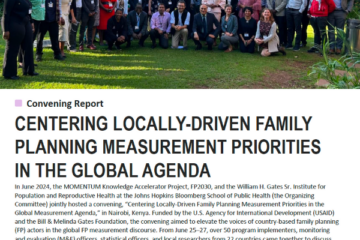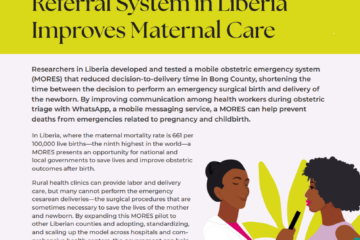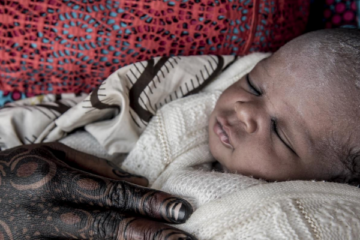
Fighting AIDS-Related Stigma in Africa
Date
December 2, 2002
Author
(December 2002) Stigma and discrimination remain a major fact of life for the estimated 29.4 million people with HIV in sub-Saharan Africa and for the more than 11 million children who have lost one or both parents to AIDS. Whether it is a worker afraid of being fired from a job or a woman terrified of losing her children and her home, well-founded fears exist for many with the virus. But despite agreement that stigma and discrimination must be overcome to turn the tide on the epidemic, communities and governments in Africa — as elsewhere — continue to struggle to protect people’s rights and dignity.
“The national AIDS plans of several African countries explicitly recognize the public health imperative underlying the promotion of human rights — an achievement in itself. Yet few governments actively promote or assist a rights agenda in relation to AIDS,” Mark Heywood of the AIDS Law Project at the University of Witwatersrand in Johannesburg has written in SAfAIDS News.
At the same time, the Joint United Nations Programme on HIV/AIDS (UNAIDS) notes that the real battle in Africa against AIDS takes place beyond the scope of governmental authority — in families and villages, where discrimination tends to be intensely personal. Reactions to the virus may be in the form of school children shunning others on the playground or in-laws spurning the widow of a son who died from an AIDS-related illness. A June 2001 meeting in Tanzania that sought to set a research agenda for stigma and HIV/AIDS in Africa described stigma within the family as being among the most subtle and debilitating forms of this problem and the hardest to address.
In the international arena, much has been done to frame HIV/AIDS as a major challenge to the human rights of those affected. Governments from around the world, including Africa, adopted a declaration at a special session of the UN General Assembly in June 2001 in New York that by 2003 they should enact, strengthen, or enforce measures to eliminate all forms of discrimination against infected people and other vulnerable groups. The right to nondiscrimination is also enshrined in a number of international instruments, including the Universal Declaration on Human Rights, the International Covenant on Economic, Social, and Cultural Rights, and the African Charter.
Nevertheless, negative reactions to people with HIV/AIDS persist, reducing the quality of life of millions. The stigma associated with HIV and AIDS causes some people to deny the risks of infection and avoid being tested, while others hide their infection, shun friends and family, and avoid seeking support and treatment. If their HIV status is revealed, those with the virus may be ostracized, refused treatment and care, or even face abuse and violence. The 1998 stoning to death of South African community volunteer Gugu Dlamini after she publicly disclosed her HIV status on World AIDS Day is one of the starkest examples of the negative attitudes related to AIDS. Such attitudes increase the epidemic’s impact on individuals, families, communities, and nations.
In South Africa, where one in nine people live with HIV, the AIDS Law Project reports that the main source of complaints over the years has involved employer discrimination and HIV testing that is performed without regard to confidentiality, people’s informed consent, or pre- and posttest counseling.
“Medical and employment malpractices are a main source of complaints and have remained fairly constant over the years,” notes the AIDS Law Project, a nongovernmental organization (NGO) that offers free legal advice and works to prevent discrimination against people with the virus. “It is interesting to note that a great number of cases involved the combination of irregular medical testing with that of employer discrimination.”
Employer discrimination may take many forms. The Southern African Development Community (SADC) has pointed out that some companies dismiss workers with the virus or hire only those believed to have a low risk of infection. In addition, many medical insurance schemes offered by companies have no HIV-related medical benefits, and some industries have even proposed overhauling their medical benefits schemes to get around anticipated HIV/AIDS expenditures. The Human Rights Monitor, produced by the Zimbabwe NGO Human Rights Forum, notes that some infected people have been denied promotion because it is felt they may die at any time.
Vulnerability to HIV and the related stigma and discrimination are linked to existing inequities and stereotypes, including racism, poverty, intolerance, and inequality between women and men. As such, the worst affected are already the most disadvantaged, whether on racial, gender, or economic grounds. In sexual relations between women and men, a woman’s safety may be compromised by a man’s opposition to condoms, the potential for abuse and violence in the relationship, and dependence on a male partner for economic or social support. At the same time, the woman may bear the blame for spreading the disease, regardless of the circumstances.
In sub-Saharan Africa, issues of gender as well as poverty, a lack of economic opportunities, limited access to education, information, and services, and traditional norms and practices significantly increase a woman’s vulnerability to HIV and lie at the root of her experience in trying to cope with the related stigma and discrimination.
Women make up the majority of adults (15-49 years old) in this region who live with HIV/AIDS — 17 million out of a total of 29.4 million, or 58 percent of all adults with HIV in sub-Saharan Africa, according to UNAIDS estimates for 2002. UNAIDS also reports that in some sub-Saharan countries, prevalence among teenage girls is five times higher than for teenage boys.
Studies show that ignorance related to HIV and AIDS is a major factor in the vulnerability of the region’s young women. Research by the United Nations Children’s Fund (UNICEF) found that among girls 15 to 19 years old, 70 percent in Somalia and more than 40 percent in Guinea Bissau and Sierra Leone had never heard of AIDS. However, a study in Zimbabwe by the United Nations Development Fund for Women (UNIFEM) indicated that even when women know about HIV/AIDS, “their economic dependence on men left them feeling ‘helpless’ to negotiate safe sex.”
The Swaziland Example
In Swaziland, a landlocked country of 1.1 million people, national government actions reflect a traditional society grappling to address an epidemic that had claimed one or both parents of an estimated 35,000 children under age 15 by the end of 2001.
In early 2000, the country’s parliament considered two motions that, though they were ultimately defeated, highlighted the prejudices and misconceptions facing people with HIV. One motion sought to create camps to quarantine those with the virus; another proposed sterilizing all infected residents. While these motions failed, the parliament did pass another to have miniskirts banned in schools, a move that appeared to distract from any real debate on prevention and education programs.
In 2001 the king announced a controversial five-year sex ban for women of marriageable age. Young women are expected to wear traditional tassels to show their virginity and are forbidden from wearing pants. This ruling is being promoted as an anti-AIDS move.
Urging greater openness and discussion of the rights of the Swazi people affected by the epidemic, a 2000 study sponsored by the United Nations Development Programme (UNDP) directly addressed these kinds of reactions.
“On a one-to-one basis, particularly at the domestic level, the reality is that people living with HIV/AIDS are stigmatized, discriminated against, and rejected,” according to the report Human Rights, Ethical Issues, and HIV/AIDS in Swaziland. Moreover, the study states, stigmatization and discrimination have contributed to the silence and denial about the HIV/AIDS epidemic in Swaziland “and has resulted in the epidemic being driven underground, contributing to the unprecedented spread of infection.”
The study shows that workers have been fired when their HIV status was discovered. It also noted, however, that many large companies are trying to address the epidemic “ethically” and to support sick employees.
Workplace policies and practices are guided by a 1998 Swaziland policy document on HIV/AIDS and the prevention and control of sexually transmitted infections (STIs). International guidelines, such as the International Labour Organization Code of Practice on HIV/AIDS, also play a role. The Swaziland policy document calls on the government to promote information and education programs to dispel myths and fears about HIV/AIDS and to promote the rights of people. However, no specific anti-discrimination laws have been instituted to protect those with the virus.
Likened to a “Switzerland” of Africa for its low regional and international profile, this kingdom of rolling hills and forests is tucked between Mozambique and South Africa and has a gross national per capita income of US$1,300 (compared with US$2,900 for South Africa), by World Bank estimates. A British protectorate until 1968 when it became independent, Swaziland’s largely homogeneous population comprises mainly Swazi people who speak Siswati and English.
Swaziland is a modern African country whose people have held steadfastly onto its traditions. The capital, Mbabane, has two gleaming, well-trafficked malls, while local merchants continue to sell their wares along the roadsides. The famous Umhlanga or “Reed Dance” festival is now being used by NGOs trying to promote messages of safe sex, HIV/AIDS, and gender rights.
Swazi Initiatives to Counter Stigma and Discrimination
With estimates of those infected with HIV at 170,000 or 33.4 percent of people 15 to 49 years old, Swaziland is among the most AIDS-affected countries in the world. In 1999, King Mswati III declared HIV/AIDS a national disaster. Later, the government established a Cabinet Committee on HIV/AIDS as well as an HIV/AIDS Crisis Management and Technical Committee, which was disbanded after it issued its national strategic plan at the end of 2001. The king formed a National Emergency Response Committee on HIV/AIDS (NERCHA) in 2002, which is administered by the prime minister’s office. NERCHA oversees implementation of the Swaziland National Strategic Plan for HIV/AIDS 2000-2005 and administers US$1.3 million in AIDS funds.
The strategic plan outlines a framework to guide a broad-based, national response that focuses on three areas: risk reduction (for infection); response management (for care, treatment, and support of those affected); and impact mitigation (to address the far-reaching effects of the epidemic on Swazi society). Under response management, the plan is to address stigma and discrimination to create a better environment for people with the virus. The strategies for accomplishing this include passing nondiscrimination legislation; developing policies to protect the rights of people with HIV/AIDS; educating communities to support those with the virus; ensuring that those who are affected receive counseling; and training community volunteers to provide care, support, and counseling.
There have been other initiatives. In early 2000, local leaders launched a national chapter of the Alliance of Mayors and Municipal Leaders on HIV/AIDS in Africa, which aims to work with the government, NGOs, the private sector, and local communities to limit the spread of HIV/AIDS and reduce the social and economic impact of the epidemic in towns and cities. In their declaration on HIV/AIDS, these local leaders address discrimination by committing to “raising awareness and changing attitudes on stigmatization, denial, rape, incest, multiple partners, and other unsafe practices.”
As part of a program to incorporate the HIV/AIDS work plans of all 11 municipalities, local leaders are being trained to address issues of discrimination and stigma and to be knowledgeable advocates on HIV/AIDS in their communities. The entire program is supported by a US$1.06 million grant from the African Capacity-Building Foundation, established and funded by the African Development Bank, United Nations Development Programme (UNDP), African governments, and bilateral donors.
Small initiatives are also coming from people with the virus. In 1993, people with HIV and AIDS formed the Swaziland AIDS Support Organization (SASO), whose goal is to share information and encourage support for people affected by the epidemic. With about 60 members and offices in three towns, SASO focuses its efforts on behavior change, support, information sharing, advocacy, and uprooting the stigma and discrimination faced by people living with HIV/AIDS and their families.
Government Focuses on Swazi Women and HIV/AIDS
The Swaziland government readily acknowledges that women have an increased vulnerability to infection. According to its policy document on HIV/AIDS, the reasons for this include:
- Limited knowledge and access to information about HIV/AIDS and sexually transmitted infections (STIs);
- Women’s economic and social dependence on men; and
- The asymptomatic nature of STIs in women, a factor known to hinder treatment and facilitate the spread of HIV.
The government recommends increased access to information and counseling and training in self-esteem, assertiveness, and decisionmaking to improve women’s negotiating position in sexual relationships and urges a review of religious and cultural traditions that can hurt women.
Gender studies by the UNDP have focused on some of the cultural practices that have added to women’s vulnerability to infection. For example, Swaziland is a polygamist society that allows men to have multiple wives and sexual partners. There are also arranged marriages and widow’s inheritance, whereby women whose husbands have died move in with their brothers-in-law who then become their surrogate husbands.
The research also found that the culture fosters submissiveness by women and male dominance. Swaziland’s women are considered legal minors: They cannot own property, enter into contracts, or receive bank loans without a male relative.
Setting the Agenda, Addressing Silence and Denial
The dynamics of stigmatization and discrimination in African societies are complex and not easy to overcome. Ignorance and misinformation intertwine with gender inequities, poverty, weak health care systems, and local customs. There is general agreement that African leaders in all areas — local, national, religious, and traditional — have a clear responsibility to encourage discussion, publicly acknowledge the ways in which they themselves are affected, and take other steps to address the silence and denial.
Although stigma and discrimination may never be eliminated, African government officials and researchers agree that interventions should aim to build responsibility and accountability. Experts attending the 2001 meeting held in Tanzania to set a research agenda on stigma and HIV/AIDS in Africa recommended action in four areas:
- The family: Responding with home-based care and other programs, bearing in mind that children face unique challenges and should be active partners rather than passive recipients in any intervention.
- Health care settings: Developing discharge and referral systems that are sensitive to people’s need for privacy; developing codes of ethics and professional conduct for health care services; and offering forms of redress when violations occur.
- The religious sector: Identifying language and doctrines that may be stigmatizing and promoting caring and nonjudgmental alternatives.
- The mass media: Developing media standards for journalists who report on HIV/AIDS; holding communicators accountable for reporting on the epidemic accurately, sensitively, and in a nonstigmatizing manner through the use of countrywide or region-specific monitoring mechanisms; and providing resources for sustained communication on HIV/AIDS that specifically addresses stigma.
The Blue Print for Action report published in July 2002 by a Global HIV Prevention Working Group, convened by the Gates and Kaiser Foundations, cites stigma as an obstacle to scaling up proven prevention strategies. In sub-Saharan Africa, openness and destigmatization will be crucial to efforts to curb the spread of this disease. At the same time, many agree that more research is needed to better understand the underlying causes of people’s negative responses.
Margo M. Kelly is a program development specialist and freelance writer based in Washington, D.C.
References
Alliance of Mayors and Municipal Leaders on HIV/AIDS in Africa (AMICAALL), Swaziland National Association of Local Authorities Declaration on HIV/AIDS: A Declaration by Mayors and Municipal Leaders of Cities and Towns of Swaziland on HIV/AIDS (January 2000).
AMICAALL, Swaziland Programme Start-Up Workshop Report (Piggs Peak, Swaziland: AMICAALL, Aug. 2001).
Global HIV Prevention Working Group, Global Mobilization for HIV Prevention: A Blueprint for Action (Bill and Melinda Gates Foundation and the Henry J. Kaiser Family Foundation, July 2002).
Health & Development Networks and UNAIDS, Regional Consultative Report, Stigma and HIV/AIDS in Africa: Setting the Operational Research Agenda (Dar es Salaam, Tanzania, June 4-6, 2001).
Mark Heywood, “The AIDS Epidemic in Africa: Openness and Human Rights,” SAfAIDS News 7, no. 1 (March 1999).
HIV/AIDS Crisis Management and Technical Committee and Deputy Prime Minister’s Office, Swaziland National Strategic Plan for HIV/AIDS 2000-2005 (September 2000).
Horizons, Stigma and Discrimination Factsheet (Washington, DC: Horizons, January 2002).
Human Rights Forum, Human Rights Monitor, no. 16 (July 2001).
International Labour Organization, Code of Practice on HIV/AIDS and the World of Work (Geneva: ILO, 2001).
International Center for Research on Women (ICRW), “Addressing HIV-Related Stigma and Resulting Discrimination in Africa: A Three-Country Study in Ethiopia, Tanzania, and Zambia,” Information Bulletin (ICRW, March 2002).
John Murphy, “AIDS Smothers African Kingdom; Swaziland: AIDS is Destroying a Nation But Shame and Misunderstanding Muffle Outcries and Stifle a Response,” Baltimore Sun, Nov. 4, 2000.
Office of the UN High Commissioner for Human Rights (OHCHR) and UNAIDS, HIV/AIDS and Human Rights International Guidelines, Third International Consultation on HIV/AIDS, Human Rights (Geneva: OHCHR and UNAIDS, July 2002).
Swaziland Government, Swaziland Today 8, nos. 2, 3, 15 (Jan. 18, Jan. 25, May 10, 2002).
Swaziland Ministry of Health and Social Welfare, Policy Document on HIV/AIDS and STD Prevention and Control (August 1998).
United Nations Development Programme/Swaziland, Gender Focused Responses to HIV/AIDS: The Needs of Women Affected by HIV/AIDS (UNDP/Swaziland, August 2000).
UNDP/Swaziland, Human Rights, Ethical Issues and HIV/AID in Swaziland (UNDP/Swaziland, August 2000).
United Nations (UN) Integrated Regional Information Network, “Swaziland Cultural Practices May Spread HIV/AIDS,” Oct. 4, 2002.
UN Special Session on HIV/AIDS, AIDS Education — A Battle Against Ignorance, Fact Sheet (Geneva: United Nations, 2002).
UNAIDS, A Conceptual Framework and Basis for Action: HIV/AIDS Stigma and Discrimination (Geneva: UNAIDS, June 2002).
UNAIDS, AIDS Epidemic Update (Geneva: UNAIDS, December 2002).
UNAIDS, An Overview of HIV/AIDS-Related Stigma and Discrimination, UNAIDS Fact Sheet (Geneva: UNAIDS).
UNAIDS, Report on the Global HIV/AIDS Epidemic (Geneva: UNAIDS, 2002).
UNAIDS, Swaziland Epidemiological Fact Sheets on HIV/AIDS and Sexually Transmitted Infections 2002 Update (Geneva: UNAIDS, 2002).

The Status of the HIV/AIDS Epidemic in Sub-Saharan Africa
Date
July 2, 2002
Author
Thomas Goliber
Senior Fellow, Futures Group International
Focus Area
Despite the fact that sub-Saharan Africa contains only about 11 percent of the Earth’s population, the region is the world’s epicenter of HIV/AIDS. The numbers are daunting. Adult HIV prevalence is 1.2 percent worldwide (0.6 percent in North America), but it is 9.0 percent in sub-Saharan Africa. UNAIDS estimates that at the end of 2001, there were 40 million people living with HIV/AIDS, 28.5 million of them from sub-Saharan African. Five million adults and children became newly infected with HIV in 2001, 3.5 million of them from sub-Saharan Africa. Three million people died from AIDS-related causes in 2001, and 2.2 million of these deaths were among sub-Saharan Africans.2
AIDS is now the leading cause of death in sub-Saharan Africa. (Worldwide, AIDS is the fourth leading cause of death.) Life expectancy at birth has plummeted in many African countries, wiping out the gains made since independence. The combination of high birth rates and high AIDS mortality among adults, including many parents, has meant that more than 90 percent of children who have been orphaned as a consequence of the HIV/AIDS epidemic are in this region.2
These statistics disguise an important part of the story, however. Most of the worst affected countries form an “AIDS belt” in eastern and southern Africa. This belt consists of about 16 countries3 and stretches from Djibouti and Ethiopia down the east side of the continent through South Africa. These countries constitute only a little more than 4 percent of the world’s population but account for more than 50 percent of HIV infections worldwide.
According to UNAIDS, all the worst affected countries (with prevalence rates over 20 percent) are contiguous to one another in the lower part of the continent. These include South Africa, Lesotho, Swaziland, Botswana, Namibia, Zambia, and Zimbabwe. Botswana, Lesotho, Swaziland, and Zimbabwe have prevalence rates above 30 percent.4
Further north in the AIDS belt, Mozambique, Malawi, Burundi, Rwanda, Kenya, Tanzania, and Ethiopia all have adult prevalence rates in the 6-15 percent range. Adult prevalence in Uganda is estimated to be around 5 percent. Uganda is the one country in the region that has probably achieved a longstanding decline in HIV prevalence. Prevalence in Uganda may have peaked in the 12-13 percent range in the early 1990s before the onset of this decline.
Elsewhere, Somalia, Eritrea, Djibouti, and Sudan have little or no data, and Madagascar remains an interesting case. Despite tourism, an active commercial sex trade, and high rates of other sexually transmitted infections (STIs), and despite being separated from the African mainland by only 60 kms of water, adult HIV prevalence remains below 1 percent.5
Though having overall adult prevalence rates lower than in the eastern and southern parts of the continent, the middle part of Africa6 is undergoing a serious and generalized7 HIV/AIDS epidemic. Among the countries in the region, the Democratic Republic of Congo, Chad, and Equatorial Guinea show adult HIV prevalence rates under 5 percent. Angola has been war-torn and chaotic for so long that it is difficult to know exactly what is transpiring with the epidemic there. However, UNAIDS places the adult prevalence rate at 5.5 percent. Elsewhere in the region, UNAIDS reports prevalence rates of 7.2 percent in the Congo, 11.8 percent in Cameroon, and 12.9 percent in the Central African Republic.8 Many of the worst affected countries in middle Africa have the highest rates of other STIs on the continent.
Among the 15 countries of West Africa,9 only a few countries have prevalence rates over 5 percent. These include Burkina Faso (6.5 percent), Côte d’Ivoire (9.7 percent), Nigeria (5.8 percent), and Togo (6.0 percent). With an estimated population of 127 million, Nigeria is the demographic giant of sub-Saharan Africa. After South Africa, Nigeria has more people living with HIV/AIDS (3.5 million in 2001) than any other place on the continent. Côte d’Ivoire receives a large number of male migrants from neighboring countries who are temporary workers. Along with a vibrant commercial sex industry, especially in the capital city of Abidjan, this helps explain why Côte d’Ivoire has emerged as the epicenter of the epidemic in West Africa.
Table 1
Estimated Number of People in the African “AIDS Belt” Living with HIV/AIDS, end of 2001
| Total Adults and Children | Total Women (15-49) | Adults (15-49) rate (%) | |
|---|---|---|---|
| Global Total | 40 million | 18.5 million | 1.2 |
| Sub-Saharan Africa | 28.5 million | 15 million | 9.0 |
| Djibouti | – | – | – |
| Ethiopia | 2.1 million | 1.1 million | 6.4 |
| Uganda | 600,000 | 280,000 | 5.0 |
| Kenya | 2.5 million | 1.4 million | 15.0 |
| Tanzania | 1.5 million | 750,000 | 7.8 |
| Rwanda | 500,000 | 250,000 | 8.9 |
| Burundi | 390,000 | 190,000 | 8.3 |
| Mozambique | 1.1 million | 630,000 | 13.0 |
| Malawi | 850,000 | 440,000 | 15.0 |
| Zambia | 1.2 million | 590,000 | 21.5 |
| Zimbabwe | 2.3 million | 1.2 million | 33.7 |
| Namibia | 230,000 | 110,000 | 22.5 |
| Botswana | 330,000 | 170,000 | 38.8 |
| Swaziland | 170,000 | 89,000 | 33.4 |
| Lesotho | 360,000 | 180,000 | 31.0 |
| South Africa | 5.0 million | 2.7 million | 20.1 |
Source: UNAIDS, Report on the Global HIV/AIDS Epidemic: July 2002.
Why have rates in West Africa not soared to the levels found in the AIDS belt countries of eastern and southern Africa? If the African epidemic has its roots in the Great Lakes region, the epicenter could well have moved westward into middle and western Africa. Instead, it moved primarily southward. The question is an intriguing one and no consensus has emerged in response. Cultural and social norms may have played a role.10 For example, in countries with conservative Islamic traditions and a large proportion of Muslims in the population, sexual networking may be more circumscribed than in other countries.
Demographers John and Pat Caldwell suggest at least two additional factors. They point out that the presence of other STIs is probably the single most important factor contributing to the rapid spread of HIV. However, it is not all STIs, but especially those that cause genital ulcers that serve as an effective conduit of HIV. In West Africa, gonorrhea is the most common STI, but this is a non-ulcerative STI and an ineffective transmitter of HIV. By contrast, syphilis and chancroid are the dominant STIs in eastern and southern Africa. Both are ulcerative STIs that greatly increase the probability of HIV transmission.
Also, in most societies in West Africa, male circumcision is almost always practiced, while it is uncommon in a very large swathe of the AIDS-belt countries.11 Several studies conducted over the last decade and a half point to an association between male circumcision in some areas of sub-Saharan Africa and a reduced risk of HIV infection. However, it is still not clear whether circumcision’s apparent protective effect is due to culturally or religiously dictated behaviors — such as limiting the number of sex partners — or what the foreskin’s biological role is in male infection with HIV and other STIs.
Is the epidemic still worsening or is the situation improving? Uganda is still the only country in the region that has achieved a sustained decline in HIV prevalence. In some places — parts of Zambia, for example — prevalence appears to be dropping among the younger age groups, a possible prelude to an overall prevalence decline.
UNAIDS indicates that in 2000 the number of annual new infections went down for the first time relative to the previous year.12 While this is an encouraging trend, a drop in the annual number of new infections over a short period does not mean very much by itself. Some eventual downturn in incidence (annual new infections) would eventually occur even in the absence of any successful prevention efforts. The high levels of incidence that drove expansion of the epidemic during the 1990s could not be sustained indefinitely. This happens, in part, because prevalence levels become so high in certain high-risk groups that there is little room for expansion. A drop in incidence over a number of years is needed before it signifies a change in the overall course of the epidemic. Also, a rise in a few key but large countries — Congo and Nigeria, for example — could see incidence climbing again.
The best assessment is that, while there are some hopeful signs, overall the epidemic continues to rage throughout the Africa region. Even if prevention efforts become radically more successful in the near future than they have been, the impacts of the HIV/AIDS epidemic are going to echo for generations. If prevention, treatment, and care programs evolve at a more modest pace, it is certain that HIV/AIDS will have a profound impact on African development well into the 21st century.
References
- The Joint United Nations Programme on HIV/AIDS (UNAIDS), Report on the Global HIV/AIDS Epidemic: July 2002 (Geneva: UNAIDS, 2002).
- USAID, Leading the Way: USAID Responds to HIV/AIDS (Washington, DC: The Synergy Project, 2001).
- The definition of the AIDS belt can vary. In this case, it includes 16 contiguous countries in eastern and southern Africa with serious HIV/AIDS epidemics. The countries are Djibouti, Ethiopia, Uganda, Kenya, Tanzania, Rwanda, Burundi, Mozambique, Malawi, Zambia, Zimbabwe, Namibia, Botswana, Swaziland, Lesotho, and South Africa.
- UNAIDS, Report on the Global HIV/AIDS Epidemic: July 2002.
- UNAIDS, Report on the Global HIV/AIDS Epidemic: July 2002.
- Middle Africa countries include Angola, Cameroon, the Central African Republic, Chad, Democratic Republic of Congo, Congo, Equatorial Guinea, and Gabon.
- One definition of a generalized HIV/AIDS epidemic is that HIV has spread beyond initial subpopulations engaged in high-risk sexual behavior to the general population, as evidenced by prevalence rates of 5 percent or more in urban areas. See, for example, Confronting AIDS: Public Priorities in a Global Epidemic, A World Bank Policy Research Report (New York: Oxford University Press, 1997): 87.
- UNAIDS, Report on the Global HIV/AIDS Epidemic: July 2002.
- West African countries include Benin, Burkina Faso, Cote d’Ivoire, Gambia, Ghana, Guinea, Guinea-Bissau, Liberia, Mali, Mauritania, Niger, Nigeria, Senegal, Sierra Leone, and Togo.
- Leading the Way: USAID Responds to HIV/AIDS.
- John C. Caldwell and Pat Caldwell, “Toward an Epidemiological Model of AIDS in Sub-Saharan Africa,” Social Science History 4 (Winter 1996): 567, 576, 578-585, 592.
- UNAIDS, AIDS Epidemic Update: December 2000 (Geneva: UNAIDS, 2000).






